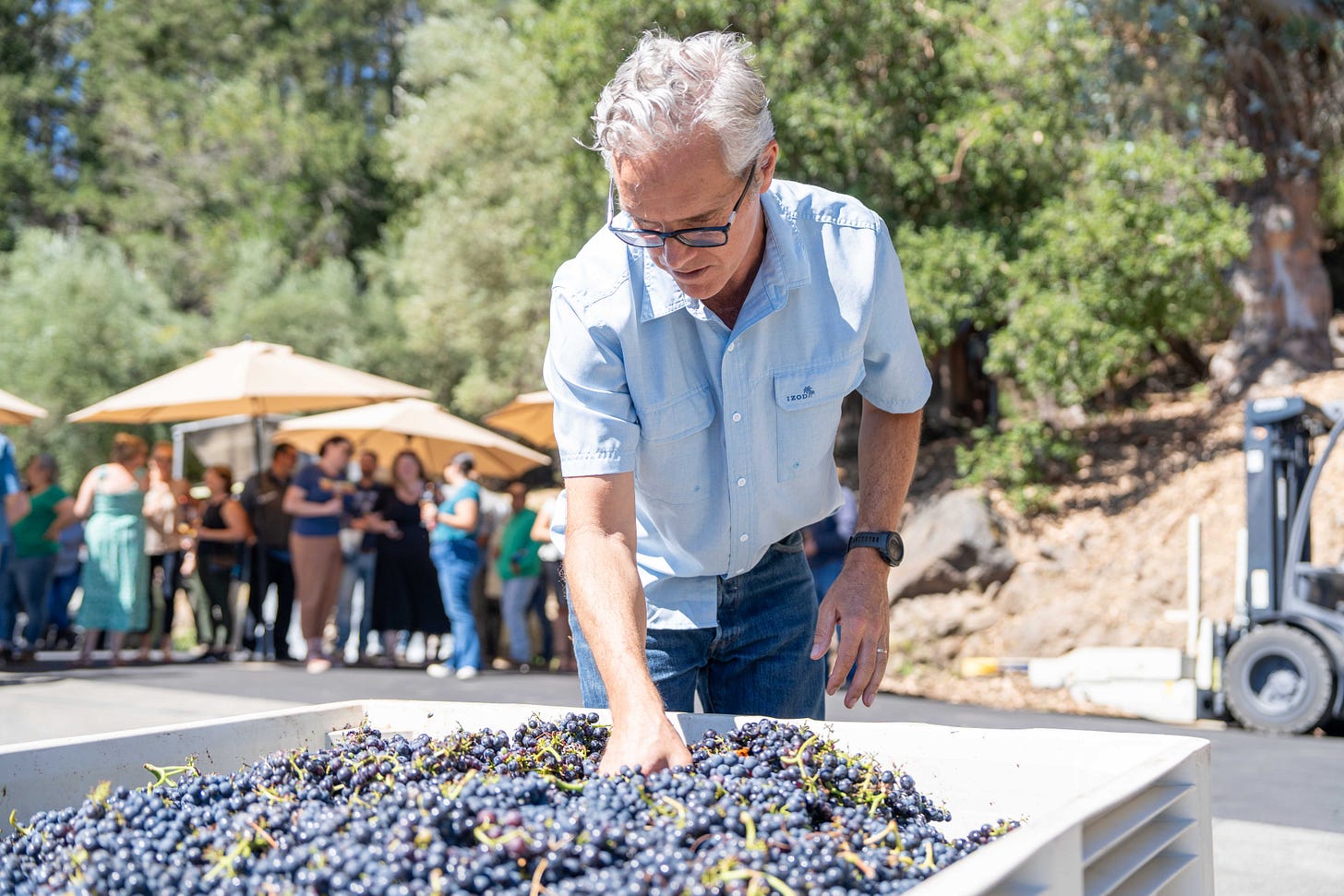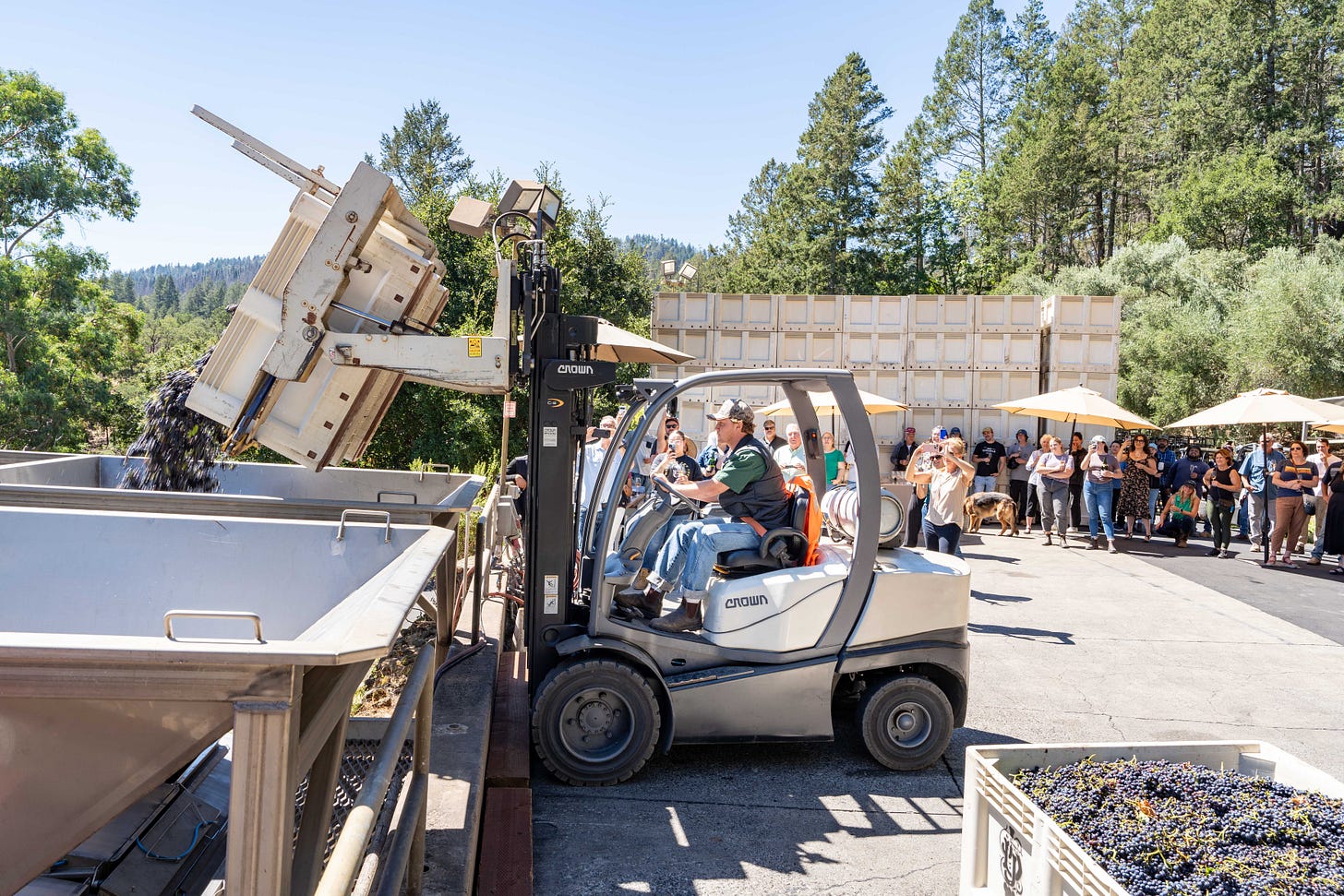CALISTOGA, Calif. — On Thursday, Aug. 15, second- and third-generation stewards of Schramsberg, along with the winery team and guests, gathered on the grape crush pad to celebrate the first grapes of the year. Continuing a cherished tradition, they sabered bottles of sparkling wine and raised toasts in honor of the occasion.

What began as a quest to revive a forgotten 19th century winery has evolved into a family legacy, producing some of the most celebrated sparkling wines in the United States. Schramsberg’s journey from its modest rebirth to its current status as a leader in American sparkling wine production reflects a vision driven by perseverance and a dedication to quality.
The Davies family and their team marked the start of the harvest with a ritual that has become emblematic of Schramsberg's enduring legacy: the ceremonial sabering of sparkling wine bottles. This act, known as sabrage, involves slicing the neck off a bottle with a saber, sending a spray of bubbly into the air — a fitting tribute to the season's excitement.
"How would we even know it was harvest without sabering a few bottles of sparkling wine?" Davies joked as he prepared to lead this year’s ceremony.
Beyond the jest lies a deep respect for tradition. The sabering ceremony is more than just a festive kickoff; it is a nod to the vineyard’s history and the ritualistic "blessing of the grapes," a practice once common in vineyards, symbolizing hope for a successful harvest.
This year’s harvest holds particular significance as it marks six decades since the Davies family revived Schramsberg. Adding to the historical resonance, Davies was born just weeks after that first harvest in 1965, as the inaugural vintage was being launched.

"It’s unbelievable to think that this is our 60th harvest," Davies said. "I wasn’t alive for the first one, but I was born right after it, so I feel a deep connection to that time. I remember harvests from the early '70s. We’ve come a long way since then."
The winery has seen significant changes over the years. When Jack and Jamie Davies first acquired the property, it was in disrepair. The couple worked tirelessly to restore the estate with a clear vision of producing world-class sparkling wines in the traditional méthode champenoise. Their dedication paid off, and by the 1970s Schramsberg had gained national attention, even being served at White House state dinners. Today, the winery thrives under the stewardship of their son, Hugh, who expanded the estate’s offerings to include a range of red wines under the Davies Vineyards label.
As the 2024 harvest began, Davies noted that this year’s start was typical for the winery, though a few Napa Valley wineries had begun their harvests the previous week.
"We’re beginning today, the 15th of August, which, for us, is maybe a day or two later than the average date," he said. "In the earliest years, we sometimes started as early as late July, which happens about once every ten years. The latest we’ve ever started was in late August, like in 2011 when we didn’t finish until early November. This year, we're right around the middle of that range."
The first grapes harvested this year were 11 tons of pinot noir from the Richburg Vineyard in Napa’s Los Carneros region. Richburg has been a reliable early-ripening site for Schramsberg for over two decades, and once again, it kicked off the harvest season. Located on Bayview Avenue in the southern part of Carneros, this vineyard consistently produces grapes that are bright, tart and clean — qualities essential for Schramsberg’s sparkling wine program, Davies explained.
"This vineyard has been our first pick for over 20 years," he said. "The fruit looks particularly good this year. With the decent rainfall we've had over the past couple of years, the vines are happy, with plenty of growth. We're expecting a good-sized crop this year."
The harvest at Schramsberg typically spans seven to eight weeks, beginning with pinot noir and chardonnay for sparkling wines and ending with cooler site vineyards in Marin County.
"We usually finish with chardonnays from Marin County, where the cool climate allows us to stretch the harvest into October," Davies said. "In 2011, we even picked into November, but that was an anomaly."
In the later stages of harvest, Schramsberg turns its focus to still wines, including pinot noir and cabernet sauvignon produced under the Davies Vineyards label.
"We’ll do pinot noir for red wine at our winery in St. Helena, followed by cabernet, malbec, merlot, petit verdot and cabernet franc from our estate vineyards here on Diamond Mountain," Davies said. "If all goes as expected, we’ll start with pinot noir around the 20th of September and continue through October."
This year’s harvest also continued a cherished family tradition, with Davies and his wife Monique joined by their sons, Hugh Jr. and Emrys, representing the third generation of the Davies family. Their third son, Nelson, recently began his first year in college and was unable to attend.
"The boys are excited to be involved, and this year Emrys is taking on a new role," Davies said. "He’s trained on the forklift and will be tipping the first bin of grapes into the press. It’s a significant moment for him and for our family."
Reflecting on Schramsberg’s 60-year journey, Davies, in a toast to the gathering spoken in English and near-perfect Spanish, expressed gratitude for the people who have contributed to the winery’s success.
"We’re lucky to have a great team here at the winery, dedicated to making delicious sparkling wines and, more recently, red wines," he said. "It’s been a long-term enterprise, and we’re excited for what the future holds."
As the bright midday sun bathed the valley floor in golden light, the sabering ceremony drew to a close, signaling the beginning of the harvest in earnest. The first press loads of pinot noir were ceremonially sprinkled with foamy sparkling wine, a gesture believed to bring good fortune for the season ahead. With Emrys' steady but careful hand, the bin of grapes was hoisted high and poured into the press, marking the start of another chapter in Schramsberg’s storied history. This ritual, a rite of passage passed down through generations, continues to embody the rich blend of history, celebration and community that defines one of Napa Valley's last remaining family-owned wineries.

If today’s story captured your interest, explore these related articles:
Dan Berger’s Wine Chronicles: Napa and Sonoma as True Vinous Siblings
Under the Hood: Charlie’s in St. Helena Is Not Only New — It’s Great
Under the Hood: Navigating the Future of the Napa Valley Model
Sunday E-dition: Retired Judge Brings Real Napa Valley Crimes to Life
Tim Carl is a Napa Valley-based photojournalist.








Schramsberg continues to produce delicious sparkling wines every year. Thank you for Tim for the story.